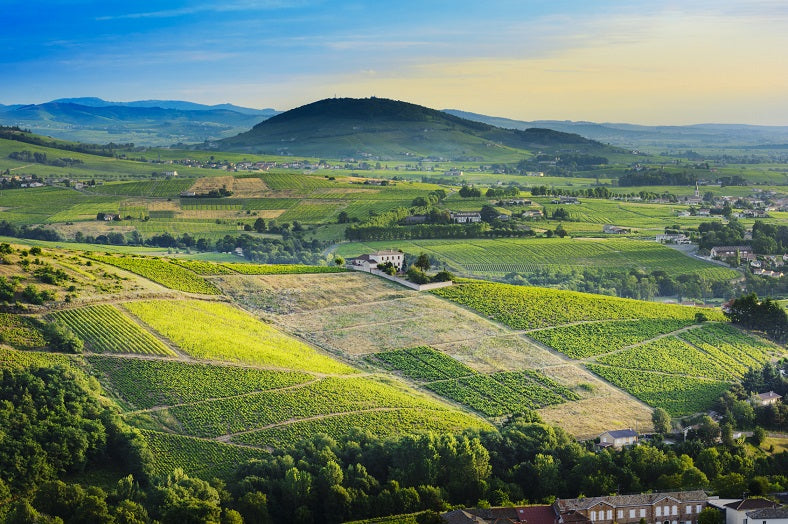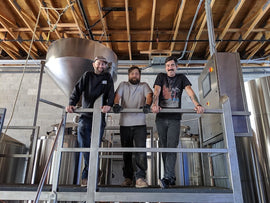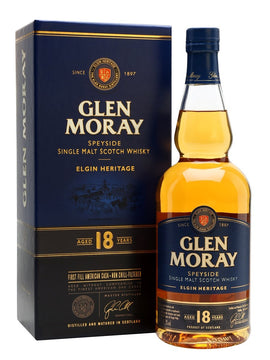Just below the Macon border, the 10 crus of Northern Beaujolais tumble south in a jigsaw befitting the region’s puzzling status among wine fans. To many, Beaujolais is the go-to for glou-glou - fun and forgettable juice. In the United States, this most often means Nouveau, the fermented-yesterday, gone-tomorrow Thanksgiving mainstay. In France, the two appellations that produce Nouveau - the Beaujolais AOC and the higher quality Beaujolais-Villages AOC - are also prized for their more traditional bottlings, which serve as the house reds of nearby Lyon, the country’s gastronomic capital. Then there is Cru Beaujolais, which consists of 10 continguous wine-producing areas mostly named for the villages they surround. From North to South, the crus are Saint-Amour, Juliénas, Chénas, Moulin à Vent, Fleurie, Chiroubles, Morgon, Régnié, Côte de Brouilly, and Brouilly. Each sits atop a specific soil composition that results in distinctive variations on Gamay Noir, the red grape of Beaujolais, first introduced by the Romans and once planted all over Burgundy. Over the last 20 years, Beaujolais has emerged as one of the most exciting and influential wine regions in the world, and the crus are most of the reason why. Technically the largest and southern most section of Burgundy, Beaujolais can boast enough age-worthy, single varietal demonstrations of terroir to rival its more venerable neighbor in the Côte D’Or, at half the price.
While the crus are most of the reason for Beaujolais recent reach, there are a couple of other contributing factors worth mentioning. One is carbonic maceration, a winemaking method popularized in Beaujolais and still most practiced there. It involves filling a sealed vessel with carbon dioxide and then adding whole, intact bunches of grapes. The initial fermentation then takes place not via yeast, but intracellularly, from the inside of the grapes out. This results in less tannic, more fruit forward wines with some distinct aromas; kirsh, banana and bubblegum, most commonly. Not all winemakers in Beaujolais employ carbonic maceration, but the technique is one of the region’s undeniable contribution to every vintner’s tool kit.
Another reason is the revolution in winemaking launched from Beaujolais in the 1980s. A quartet of vignerons, later dubbed the Gang of Four (Marcel Lapierre, Guy Breton, Jean-Paul Thévenet, and Jean Foillard) began rejecting high yields and industrial production in favor of organic, terroir-sensitive, minimal -intervention farming and production. “Natural Wine” as a thing may have started here, and most of the cru winemakers in Beaujolais today are the spiritual (and sometimes literal) progeny of these pioneers. This month we are spotlighting three of our favorites of this new generation. They make wine that embraces all the best facets of Beaujolais. These are bottles you can cellar for a few years, serve alongside all kinds of cuisine, or just enjoy on their own. Their quallity suggests the future of Beaujolais is in great hands.
Named for the 15th century windmill that crowns one of its many hills, Moulin à Vent (windmill) is unofficially known as the “King of Beaujolais” and many afficionados believe it is responsible for the region’s very best wines. Moulin à Vent occupies 660 hectares straddling the communes of Romanèche-Thorins and Chénas and produces the most full-bodied, tannic and age-worthy expressions of Gamay on the planet due to its unique soil composition. Built on a granitic base, like the rest of northern Beaujolais, the soils of Moulin à Vent also boast a high concentration of manganese, a hard grey metal people once called “glassmaker’s soap”, because it was used to decolorize glass. Too much manganese can kill a vine, but fortunately the soils in Moulin a Vent only feature enough to stunt growth significantly - limiting yields but concentrating flavor. Domaine Paul Janin & Fils dates back to 1918, and over four generations of family winemaking has developed a sterling reputation for devotion to craft and integrity. The “Vignes de Tremblay” bottling is sourced primarily from the estate’s oldest vineyards.
Bordering Moulin à Vent to the southwest, and sharing its throne, is Fleurie, called the “Queen of Beaujolais” because of the elegant floral character its wines tend to exude (though, strangely enough, the Cru is actually named after the Roman general Floricum, not the French word for flower.) The soil here is mostly pink granite underneath steep green hillsides, producing lush and lively wines, not as tannic as Moulin à Vent, but with great concentrated fruit and acidity. Domaine Chapel is a remarkable recent Beaujolais success story, founded by spouses and food and wine industry veterans David Chapel and Michele Smith in 2016. Charbonnières is a hillside vineyard on the edge of a forest that they purchased from Fleurie legend Yvon Métras, considered by some the greatest winemaker in Beaujolais. Too steep for horses or tractors, it has been farmed by hand organically for 20 years and yields Fleurie with an herbaceous complexity to complement the floral signature.
Côte de Brouilly, one of the smallest crus in Beaujolais, exists on the slopes of Mont Brouilly, an extinct volcano. It is surrounded on all sides by Brouilly, the largest and southern most of the 10 Crus. The distinction is generally that Brouilly produces lighter more sensuous wine while, Côte de Brouilly, on account of its volcanic soil and better exposure and drainage, has more depth and structure. But Alex Foillard, son of legendary Morgon vigneron and Gang of Four member Jean Foillard has been known to blur these boundaries. At the tender age of 24, he purchased a hectare in each cru, and he makes silky, aromatic and structured wine from both that will drink beautifully for years to come.
Cheers!
The PlumpJack Wine Buying Team
|
Location: Moulin à Vent, Beaujolais |
About the winemaker: Paul Janin and his family have tended their Gamay vines for generations. Paul’s son, Eric, is very much a product of this place; he is a fourth-generation grower, overseeing the fruit from its inception in the vineyard to its final resting place in the bottle. The grapes are farmed using lutte raisonnée methods, and the flaky, pink granite soil produces structured, powerful wines that gain even more character as they age. Bright, firm and earthy, they are reminiscent of the great terroirs of the Côte de Nuit. About The Winemaking: 100% Gamay Noir with white juice with a yield of 13 hectoliters per hectare depending on the vintage. The vines, mostly 40 to 70 years old, are traditionally grown in a low goblet. The other 10-year-old plots are driven in a short double cordon. Harvest is done manually in small boxes of 35 kilos. Sorting on a vibrating table. Vinification in whole bunches for 12 to 15 days before pressing. De-stemming possible depending on the vintage. Plot aging in vats for 10 months on fine lees with micro-oxygenation. Blending before bottling. Tasting Notes: Nicely aromatic with notes of cherry, cranberry and strawberry. On the palate, firm tannins and vibrant acidity frame fresh red fruit that is flecked with notes of violet and anise. The finish is concentrated and refreshing. |
|
Winemaker: Paul & Eric Janin |
|
|
Price per bottle / Price per case: $27/$291.6 |
|
|
Suggested Food Pairing: Mushroom Risotto Seared Pork Loin Grilled Lamp Chops |
|
|
Location: Fleurie, Beaujolais |
About the Winemaker: Domaine Chapel is a Beaujolais estate founded by husband and wife team David Chapel and Michele Smith-Chapel in the cru village of Régnié. It was in Beaujolais, while working at Domaine Lapierre in 2013, that David met Michele, a wine director at the celebrated Chef’s Table at Brooklyn Fare in New York. After living together in New York, the Chapels returned to Beaujolais to found Domaine Chapel. The Chapels produced their first wine - a 2016 Juliénas “Côte de Bessay” - in partnership with Mathieu and Camille Lapierre, winemakers and owners of acclaimed Morgon estate Domaine Lapierre. Currently farming 4 hectares of vines on the slopes of Beaujolais, Domaine Chapel is divided between the crus Chiroubles and Fleurie. Working by hand, in organic agriculture, the focus is always to promote the health of the soil and work with respect for the natural environment. About the Winemaking: . The wine is from the single lieu-dit, Charbonnières, which sits at 460 meters in altitude and faces directly east. The parcel is planted to high density, free-standing, gobelet vines. The Charbonnières climat is formed as an amphitheater high up in the mountains of Beaujolais and bordered by the forest which forms a natural clos around the parcel. The land has been farmed organically for nearly 20 years and is worked entirely by hand. The vine age varies and the oldest vines are over 60 years old while the youngest were replanted 30 years ago. Granite rock forms the bedrock and the soil is a mix of granitic sand, weathered rock fragments, and igneous rock. The grapes were hand harvested the second and third week of September. The whole cluster bunches go through a semi-carbonic maceration using their indigenous yeasts. The grapes fermented as whole berries for 2-3 weeks before being pressed. An assemblage was later made from the free run juice and the pressed juice. The wines finish fermentation in the spring and are bottled unfiltered. Tasting Notes: Fine fragrant red fruits and violets on the nose leads to a medium bodied palate of raspberries and red currants, background by a faint fennel note and elegantly finished with a fine, saline minerality. |
|
Winemaker: David Chapel & Michele Smith |
|
|
Price per bottle / Price per case: $42/$453.6 |
|
|
Suggested Food Pairing: White Bean Stew Roast Salmon Baked Chicken |
|
|
Location: Cote de Brouilly, Beaujolais |
About the Winemaker: The son of legendary “Gang of Four” Morgon producer Jean Foillard, Alex’s involvement in the family business began at a young age, as he took an early interest in the vineyards and enjoyed helping his father pick grapes during harvest. Intent on carrying on the family tradition of producing handcrafted cru Beaujolais, Alex studied agriculture at the Lycée Agricole in Montpellier, then earned a degree in viticulture and enology in Beaune, while simultaneously interning at a well-respected domaine in Nuits-Saint-Georges. Upon finishing his studies, he sought to earn further experience in vinification via additional internships in Australia plus another with a producer in Japan. Upon returning home to the Beaujolais, in 2015, Alex truly began dedicating himself to the family domaine. The following year, at only twenty-four years old, he purchased his very own vineyards. With roughly a hectare each in the crus of Brouilly and Côte-de-Brouilly, Alex successfully diversified the Foillard cellars, until then full of Morgon along with the odd barrel of Fleurie. Though the vineyards were not certified organic, he immediately began working them according to organic principles. The 2016 vintage marked his first harvest. About the winemaking: From north-facing lieu-dit Chavanne. Whole cluster fermentation using natural yeasts in concrete tank for 21 days. Pumpovers take place once a day for first three days. Aged 100% in concrete tanks for five months Bottled unfined and unfiltered and aged 6 months in bottle Tasting Notes: A highly aromatic bouquet of kirsh, violet and spice leads to a palate of succulent red berries and blood orange with a mineral spine. The long finish is shaped by late-arriving, fine-grained tannins. |
|
Winemaker: Alex Foillard |
|
|
Price per bottle / Price per case: $48/$518.40 |
|
|
Suggested Food Pairing: Shrimp Curry Roast Turkey Mapo Tofu
|
|





